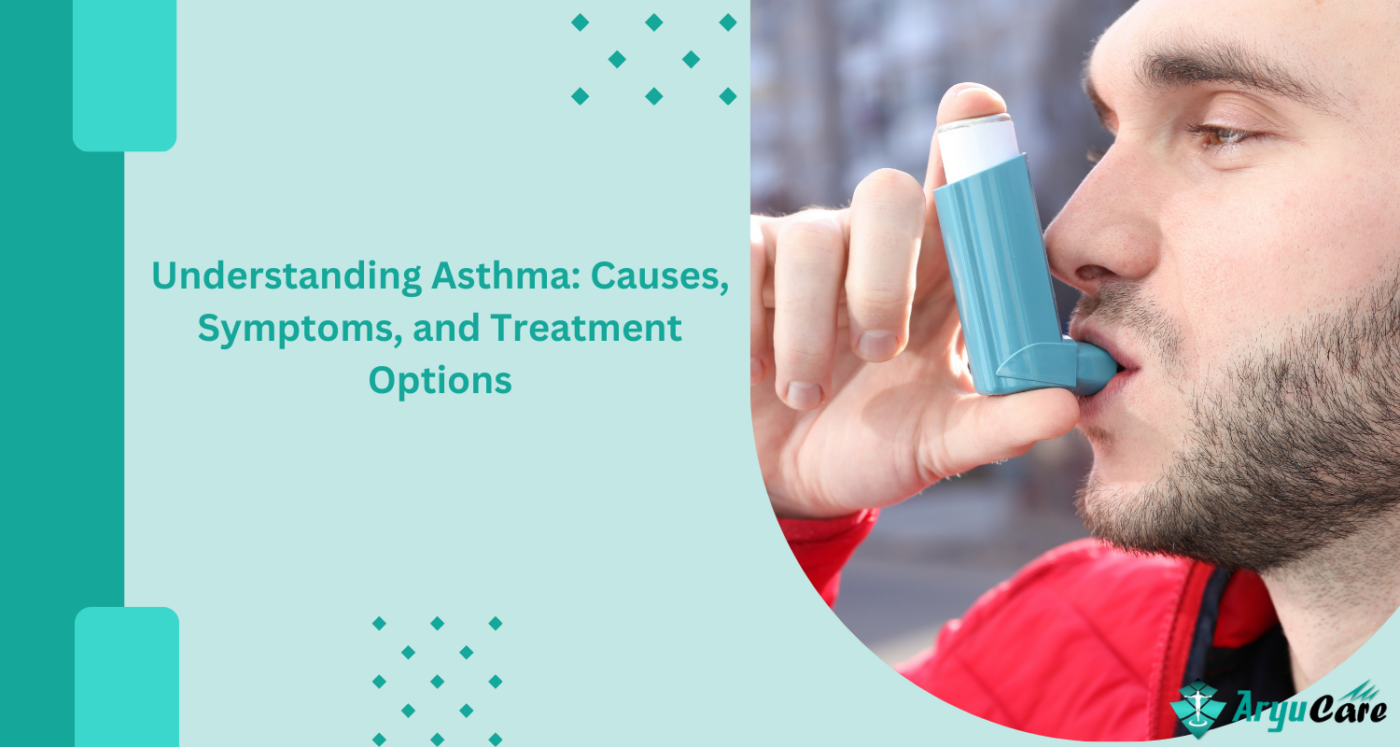Asthma
Understanding Asthma: Causes, Symptoms, and Treatment Options
An asthma attack is a short-term worsening of asthma signs and symptoms, and if not well controlled, it can be fatal. In asthma, the bronchial tubes in the lungs swell up and narrow during an asthma attack, hence making it very hard to breathe.
Some of the signs of an asthma attack are very difficulty breathing, whistling sound while breathing, coughing, and feeling of tightness in the chest.
The causes of an asthma attack may be different but are associated with exposure to allergens, irritants, respiratory infections, or vigorous exercise.
Constriction of the airways can occur due to contraction of the muscles surrounding the trachea and bronchi. Moreover, inflammation leads to the production of more mucus, which blocks the airways.
During an asthma attack, early intervention is crucial, and it is usually done with a short-acting bronchodilator (albuterol) to help ease the constriction of the airways.
In severe cases, it is advisable to seek medical help, and sometimes, admission to the hospital may be necessary.
Asthma Symptoms
Asthma is characterized by inflammation of the bronchial tubes and thickened mucus lining the tubes. In asthma, symptoms occur when the airways become narrow, swollen, or blocked by thick mucus.
There are three significant signs of asthma: There are three significant signs of asthma:
Inhaling and exhaling normally, the rings of muscles around the airways are also relaxed, and air can pass through easily. However, when you have asthma, the muscles constrict. It is more challenging for the air to get through.
Asthma leads to inflammation of the bronchial tubes in your lungs, making them red and swollen. This inflammation can harm your lungs. This is something that needs to be addressed in order to control asthma in the long run.
Asthma is a condition in which the airways are sensitive, and they close or constrict when exposed to even the slightest stimuli.
These problems may cause symptoms such as These problems may cause symptoms such as:
- Coughing at night or in the morning
- Wheezing is a whistling sound that is produced during the process of breathing.
- Shortness of breath
- The sensation of tightness pa, in, or pressure in the chest
- Breathing difficulties that result in sleeplessness
It is important to note that asthma attacks do not affect all people in the same manner, and everyone does not have the same symptoms.
You might not have all of these symptoms, or you may have some of them at one time and others at another time. Your symptoms may also differ in different attacks; you may have mild ones at one time and severe ones at another.
In some cases, asthma may not show any symptoms for a long time and then suddenly flare up. Some may have issues on a daily basis. Some people may have asthma, like when exercising or when they have viral infections like the flu.
What Causes Asthma?
It is not clear why some people develop asthma, and others do not, even among those who have risk factors. If one or more members of your family have asthma, hay fever, allergies, or eczema, your chances of developing asthma are higher.
Children are at a higher risk of developing asthma if: Children are at a higher risk of developing asthma if:
- They were born pre-term or low birth weight.
- Their mother smoked during pregnancy; they live with other people in a house and some of them smoke.
- They have been exposed to air pollution or mold.
Healthy adults can also develop asthma after extended exposure to Healthy adults can also develop asthma after extended exposure to:
- Emissions, such as fumes that affect the respiratory tract
- Inhaling dust that they are sensitive to.
Asthma can develop in athletes if they continue to train intensively and breathe in polluted, cold, or dry air.
Common triggers of asthma are: Common triggers of asthma are:
- Particles, including pollen, dust, food, and mold (allergic asthma)
- Cigarette smoke, burnt vegetation due to fires, and car exhaust fumes
- Other triggers like detergents, soaps, polishes, aerosols, fragrances, and some substances used at the workplace
- Physical activity
- Infection from viruses
The type of asthma that is brought on by exercise is referred to as exercise-induced asthma. Asthma that is caused by allergens present in the air during stormy weather is referred to as thunderstorm asthma.
Types Of Asthma
Asthma is not a single disease; it is classified into several types, and each type is managed differently. These categories can be further classified as allergic and non-allergic asthma, and based on the age of onset, such as early childhood asthma, asthma that develops during school age, and adult-onset asthma.
It is also expected to find people with asthma also having allergies, and this is referred to as allergic asthma.
Occasionally, people with no other health problems will have asthma when exercising, a condition that is referred to as exercise-induced bronchoconstriction or exercise-induced asthma.
Occupational asthma is also common among those who work in areas that have fumes, gases, and other substances. Last of all, millions of children get asthma at the initial stages of their development and are said to have childhood asthma.
Asthma Treatment
Asthma medications will assist you in maintaining an active and regular lifestyle. Two essential drugs are used in asthma treatment. Two essential drugs are used in asthma treatment:
Steroids and Other Anti-Inflammatory Drugs help to avoid asthma attacks and act by decreasing inflammation and mucus in the passage to your lungs. They are less sensitive this way and less likely to respond to the environment as most airways do.
Bronchodilators help to alleviate the signs of asthma by calming the muscles that can contract around the airways. This assists in the opening of the airways.
Rescue inhalers are short-acting bronchodilator asthma inhalers that are used to relieve the cough, wheeze, chest tightness, and shortness of breath associated with asthma.
They are also taken before any form of exercise. These should not be taken on a daily basis as a routine in the management of asthma. If you require a short-acting bronchodilator for a rescue inhaler more than two times a week, then your asthma needs to be better managed.
Sustained-release beta-agonists are sometimes used together with inhaled corticosteroids for the management of asthma or when a person has persistent asthma despite the use of a daily inhaled corticosteroid.
Inhalers for asthma are the most common and efficient methods of administering asthma drugs to the lungs. There are various types of them, and it is essential to know how to use each type in order to get the best results.
While some inhalers contain one drug, others are made up of two different drugs.
What Is Asthma Control?
Asthma control is the ability to minimize the frequency of asthma symptoms and prevent the occurrence of acute asthmatic episodes. It includes the prevention or minimization of symptoms such as coughing, wheezing, and shortness of breath.
These are actions such as taking medications, identifying and avoiding asthma triggers, adhering to an asthma management plan, and monitoring the disease using tools like the ACT questionnaire.
The aim is to reduce the frequency and severity of asthma episodes and ensure that the lung function is as close to normal as possible.
Prevention
Is it possible to prevent asthma in children?
It is impossible to prevent childhood asthma as the cause of the condition is still unknown. Furthermore, if your child has an immature immune system, you may develop asthma as well.
What steps can I take to reduce my child’s risk?
While childhood asthma is not avoidable, there are some measures that parents can take to reduce the chances of the child developing asthma. These steps include:
- Maintenance of the house to avoid mold and dampness.
- I am staying as far away from polluted air as is humanly possible.
- The role of a parent in assisting your child to achieve a healthy weight.
Diagnosis Of Asthma
There is no specific test for asthma, and the diagnosis is usually based on the medical history and physical examination. Instead, the doctor goes through a list of criteria to decide whether a person has asthma or not. These can be
- Your health history
- Family health history
- An assessment of your breathing during a physical examination
- Diagnosis of allergies through allergen tests
Pulmonary Function Tests, or PFTs, are tests that assess the volume and capacity of air that you can inhale and exhale into the lungs.
Physicians do not perform any tests on children because the results are not always correct. Instead, they give the patient some medication to check whether the symptoms will change or not. In adults, on the other hand, a bronchodilator or other asthma medication may be given to check whether the symptoms change.
Self-care
The families and patients with asthma are required to be educated more about their condition. This includes the kind of treatment they are allowed, activities that should be avoided, and how to deal with the symptoms at home.
Asthma patients should understand how to step up their treatment during an exacerbation to prevent an attack. Healthcare practitioners often provide asthma management plans to assist people with asthma to have better control over their condition.






I found the section on asthma triggers particularly insightful. It’s surprising how common household items can trigger asthma attacks. Thank you for raising awareness!
Great job explaining the causes and symptoms. I would love to see a follow-up article on how asthma affects people differently around the world and what global initiatives are in place to combat it.
I found the section on the causes of asthma really enlightening. Are there any ongoing studies about potential new triggers that researchers are looking into? More information on that would be fascinating!